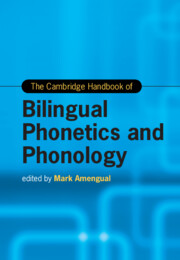Book contents
- The Cambridge Handbook of Bilingual Phonetics and Phonology
- Cambridge Handbooks in Language and Linguistics
- The Cambridge Handbook of Bilingual Phonetics and Phonology
- Copyright page
- Dedication
- Contents
- Figures
- Tables
- Contributors
- Acknowledgments
- Introduction Bilingual Phonetics and Phonology
- Part I Approaches to Bilingual Phonetics and Phonology
- Part II Theoretical Models of Bilingual Phonetics and Phonology
- 7 The Perceptual Assimilation Model: Early Bilingual Adults and Developmental Foundations
- 8 The Second Language Linguistic Perception Model
- 9 The Automatic Selective Perception Model
- 10 The Ontogeny Phylogeny Model
- 11 Bilingual Speech and Exemplar Theory
- Part III The Phonetics and Phonology of the Bilingual Child
- Part IV The Phonetics and Phonology of the Bilingual Adult
- Part V The Diversity of Bilingual Speakers
- Part VI Variables and Outcomes of Bilingual Speech
- Index
- References
11 - Bilingual Speech and Exemplar Theory
from Part II - Theoretical Models of Bilingual Phonetics and Phonology
Published online by Cambridge University Press: 14 November 2024
- The Cambridge Handbook of Bilingual Phonetics and Phonology
- Cambridge Handbooks in Language and Linguistics
- The Cambridge Handbook of Bilingual Phonetics and Phonology
- Copyright page
- Dedication
- Contents
- Figures
- Tables
- Contributors
- Acknowledgments
- Introduction Bilingual Phonetics and Phonology
- Part I Approaches to Bilingual Phonetics and Phonology
- Part II Theoretical Models of Bilingual Phonetics and Phonology
- 7 The Perceptual Assimilation Model: Early Bilingual Adults and Developmental Foundations
- 8 The Second Language Linguistic Perception Model
- 9 The Automatic Selective Perception Model
- 10 The Ontogeny Phylogeny Model
- 11 Bilingual Speech and Exemplar Theory
- Part III The Phonetics and Phonology of the Bilingual Child
- Part IV The Phonetics and Phonology of the Bilingual Adult
- Part V The Diversity of Bilingual Speakers
- Part VI Variables and Outcomes of Bilingual Speech
- Index
- References
Summary
Evidence that listeners attend to and track subphonemic phonetic details is indicated by listeners’ ability to reliably connect subphonemic variation and, often, socio-indexical associations in ways that align with the patterns realized in production. Bilinguals are presented with the task not only of associating within-language variation (e.g., social group X is connected to a particular range of phonetic realizations within language Y) but also of attending to how ethnolects and bilingually accented speech index social categories across languages. Having access to multiple languages also gives bilingual speakers a larger repertoire with which to index language- and community-specific social meaning. This chapter outlines the linguistic structures bilinguals may connect across their languages and then presents a specific exemplar model, noting the opportunities within the model’s structure for bilingual dynamics. The heterogeneity of bilingual individuals and speech communities is necessarily addressed, as this dynamic adds to the complexity and intrigue of studying bilingual populations.
Keywords
- Type
- Chapter
- Information
- The Cambridge Handbook of Bilingual Phonetics and Phonology , pp. 241 - 260Publisher: Cambridge University PressPrint publication year: 2024

